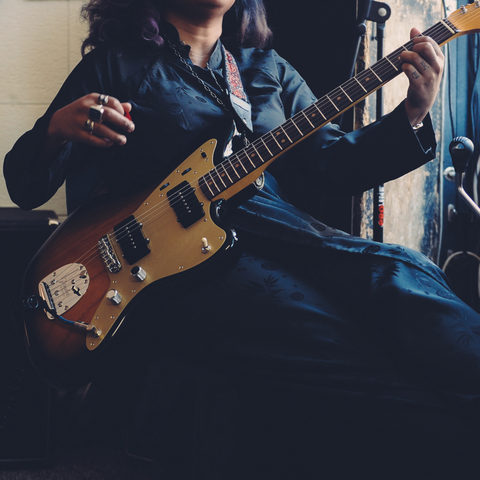

Originally released in 1958, the Jazzmaster® was overlooked by the artists it was designed for and eventually discontinued. Left to dwell in pawn shops and dusty stock rooms, it was discovered and embraced by musicians who used it to create entirely new sounds and genres, from surf and noise rock to shoegaze and alt-country. 60 years after its introduction, the Jazzmaster remains the go-to for the misfits and anti-heroes looking for new ways to push the creative boundaries of music.

AJ HAYNES: THE STRUGGLE AND POWER OF THE FEMALE VOICE
Take a look at any festival lineup and it becomes glaringly obvious that there’s a huge gender inequality problem in the music industry. Though promising progress has been made in the last few years to ensure female artists are better represented, it’s still male artists and their voices that dominate airwaves, live music bills, and media coverage. There’s also a similar imbalance when it comes to cultural diversity, particularly in America’s rock scene. But listening to AJ Haynes, the black female guitarist and vocalist of Louisiana rock ‘n roll band, Seratones, you wouldn’t believe either to be true. When Haynes strums her guitar and begins to sing, the only problem that seems to exist is how high your speakers can go without blowing up.

That’s not to say the Shreveport musician hasn’t experienced her fair share of shit as a female singer fronting a Southern rock band—it just means she’s not gonna let it get in her way. “Everyone has struggles, and I think for women, part of our struggle is figuring out how to occupy space and how to be heard, how to navigate a system that was not created for you, you know? I’m kind of a bull in a china shop most of the time, so if someone does have a problem, they can kiss my black ass. That’s how I really feel about it”, she says.
Still, the expectations that come with the role aren’t lost on Haynes. In life, everyone’s got an opinion, but when it comes to a female lead on stage, everyone’s really got an opinion. “People are so inclined to tell women how we process things and our emotional processes, or what they should look like, what you need to buy to quell them, what you need to buy to take up less space or have less pores, or just not be out”, she says. “And there is, on the one hand, a kind of fetishization, and on the other hand, kind of just awe, like, ‘what is that up there?’ ‘What does that mean?’” And so, what is the answer? What does it actually mean to be a female musician? “Fucked if I know. I’m figuring it out just like everyone else is—day by day, error by error, win by win.”

Haynes spent her childhood in rural Louisiana, where she said the open space and lack of “helicopter parenting” was ideal because “there was just this understanding that I’ll be okay. But, like, obviously look out for poisonous snakes—don’t play with the black widows.” After attending school and college together, Haynes and the rest of the band began putting on DIY shows in the Shreveport area.
Living in a place like Shreveport—an underdog city “that never should have been here”—is bound to influence a band’s sound. For Haynes and the Seratones, the crisscrossing of past achievements with current progress has had a huge impact on their music and writing progress. “I’d say, as far as influencing my sound, [Shreveport] is kind of in the middle of so many different influences. There’s a struggle between the past and the present—this kind of infatuation or kind of rose tinted glasses or remembering our history in a way that’s kind of nauseating. And that kind of discontent is really good for song writing.” Though Haynes feels that growing up in a culturally isolated city has its pros and cons, “the weirdness I experience here just is. It isn’t like a put on, or trying to be cutting edge, it’s just like, ‘I’m bored and what do I do with my hands?’” Listening to her play, it sounds like she’s found the perfect thing.


LIMITED EDITION 60TH ANNIVERSARY '58 JAZZMASTER®
The first Jazzmaster, introduced in 1958, was unlike anything else the world had ever seen. It looked and sounded like the future, with its revolutionary offset waist, distinctive pickups, flexible rhythm/lead circuit and the first rosewood fingerboard ever on a Fender. It’s as ground-breaking today as it was back then, as evidenced by this faithful homage to that original prototype.

